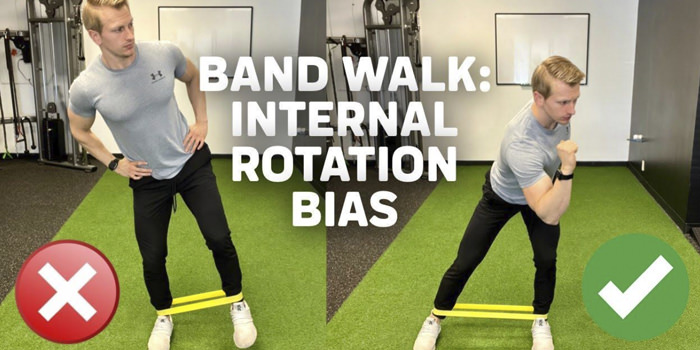
Introduction
Band walks are a classic exercise in physical therapy and strength and conditioning. You will see it most frequently programmed to improve hip abduction strength for functional activities such as gait or generalized weakness. But, believe it or not, the band walk can be a beneficial exercise to improve hip internal rotation deficits. In this article, I'll discuss the following topics to help you enhance your coaching of the modified band walk.
- Missed Assessment Opportunities
- Human Asymmetries
- Three Executional Problems with a Traditional Band Walk
- Coaching Cues to Improve Hip Internal Rotation (IR)
If you're a visual learner, click the video below to watch the same concepts discussed.
YouTube
Missed Assessment Opportunities
To truly understand band walks, you need to step back and know why you chose the exercise in the first place. Unfortunately, the answer to the why is usually unknown or a result of a random exercise prescription. Fortunately, you are reading this article and will experience a paradigm shift in your assessments.
When assessments are performed correctly with intent, you'll shed light on your patient's movement compensations, strengths, weaknesses, and patterns. These qualities will be your guide to optimal exercise prescription and programming. So, assessments are ultimately the source that should bring you to your decision of selecting a band walk.
The problem is that many physical therapists and trainers don't walk away from their assessments with this knowledge. Time is taken to obtain the puzzle pieces, but the puzzle never gets put together. To complete the "puzzle," you must carry your assessments through to your exercises. When this is achieved, you'll know why you choose a movement like the band walk every time you prescribe it.
Human Asymmetries
Since we now have a better assessment strategy, understanding human asymmetries is worth mentioning. Most of us tend to be biased towards turning to the right, otherwise described as right internal rotation. Your patient or client will represent this positional asymmetry with a significant difference in internal rotation (IR) range of motion measures. When your patient is positioned in right internal rotation, they will have increased IR measures on the right compared to the left. Instead of writing this off as a "tight" muscle, we need to understand that it means our patient is turning towards the right.
As a result, most patients have difficulty turning to the left, otherwise known as left hip IR. We can strategically modify band walks to improve our patients' weaknesses and faulty movement patterns to fix this. However, before coaching them, we need to understand the three common executional compensations of a traditional band walk to ensure we don't allow them to follow us in our IR-biased band walk.
Three Executional Problems with the Traditional Band Walk
Problem #1 - Bilateral Execution
Remember, you took an entire session to perform your assessment. You looked at different movements, ranges of motion, strengths, etc. While assessing, you found hip range of motion asymmetries. However, you perform it bilaterally when it's time to prescribe exercises like the band walk.
Is that really what's best for the patient?
Is this exercise prescription with intent?
This scenario is too common in the physical therapy world and even more familiar with band walks. Most of the time, the patient doesn't need to perform traditional band walks bilaterally, but this is how it's performed for one reason or another. Instead, become more aware of which side of the body needs what type of motion so your specific exercises can address their dysfunction.
Problem #2 - Poor Execution
The traditional band walk is one of those exercises that will almost always come with compensation. Unfortunately, the overall exercise position sets most patients up for "failure." For instance, it's too easy to add the complementary trunk lean to assist in femoral abduction. Combine that with lower extremity weakness, and you have the perfect recipe for a lot of motion, just not the correct motion. Instead, you may be able to find better exercises that positionally set your patients up for success compared to the traditional band walk.
Problem #3 - Low Standards of Execution
The traditional band walk somehow ends up in every patient's warm-up. As a result, it commonly becomes labeled as a general movement exercise instead of serving a specific purpose. If that's your intention, it's not necessarily "wrong." However, I challenge you to raise your movement standards so every exercise your patient has is backed by a purpose with a specific outcome.
Coaching Cues to Improve Hip Internal Rotation
The femur moves on the pelvis during the traditional band walk, making it an open-chain exercise. However, we will change the movement by having the pelvis move on the femur, making it a closed-chain exercise. This is achieved by the pelvis moving on the femur to create internal rotation instead of femoral abduction. This internal rotation occurs as we begin to turn and move toward the direction of that turn. Therefore, we can modify band walks to address our patients' internal rotation deficit with three simple cues.
Coaching Cue # 1 - "Step"
To initiate the movement, instruct your patient to "step." The step should be slightly outside shoulder width with the lead leg, which causes knee flexion and knee extension on the contralateral leg. Although this is a simple step in the exercise, it will throw off the exercise from the beginning if the step is too narrow or wide (see below).
Coaching Cue #2 - "Shift"
Now that you have cued your patient to step, they need to shift their body weight appropriately over the lead leg. Although this sounds like a reasonably simple action, it's not uncommon for compensation to occur. The two main compensations that usually are attempted are as follows:
- Shifting the thorax over, but not the hips.
- Shifting the hips over, but not the thorax.
We can reduce the chance of this compensation by cueing the patient to shift their nose over their lead leg big toe. In doing so, you'll see the whole body will move appropriately in an attempt to have the nose over the toe.
In addition to the body weight shift, we also want our patients' arms to shift. Therefore, their lead sidearm will go straight back while their contralateral arm bends and moves towards their lead knee. This turn toward the lead knee is the key performance indicator of the internal rotation bias. As this happens, the sacrum shifts towards the lead leg, creating a turn and a biomechanical position of internal rotation.
Coaching Cue #3 - "Lift"
We have successfully coached our patient to step and shift. Now, we approach the most challenging part of the movement, the"lift." The lift is complex because the patient needs to stay exactly where they are as they lift their contralateral leg to bring it towards the lead leg. When they perform this, cue them to lift their leg as if slowly stepping over a hurdle.
During this portion of the movement, three main compensations will have to be avoided:
- Sliding the leg, not lifting.
- Standing as the leg is lifting.
- Kicking out of their position as the leg is lifting.
If the patient can avoid these compensations, you will begin to see improvements in hip internal rotation deficits. These improvements transpire because the entire exercise, from start to finish, helps them re-capture hip internal rotation range of motion. Then, they can learn how to stabilize and strengthen it.
Conclusion
Although the step, shift, and lift band walk is challenging, it can be beneficially prescribed to improve hip IR deficits. To understand which side to perform it on, don't forget to utilize your assessments for your answers. Once the limitation is identified, coach your patient through the modified band walk and then re-test their hip IR to see the improvement.

Dr. Brian LeRiche is a physical therapist and strength coach. He owns Performance Redefined and is the creator of The PR Club. He is passionate about teaching students and professionals how to truly raise their standards and redefine their limits in and outside of the gym! To learn more from Brian, check out his website HERE.











1 Comment